Finding fantastic finches during February’s Great Backyard Bird Count
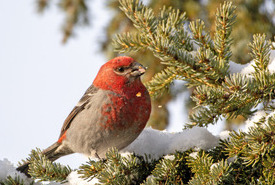
Pine grosbeak in winter (Photo by Sean Feagan/NCC Staff)
Some people relish raptors. Others prefer partridges. Me, I’m a songbird guy.
At this time of the year, my favourite birds, neotropical migrants like our wood warblers, vireos and flycatchers, have left us for warmer locales — and who can blame them? But, there are still many incredible songbirds to enjoy over the winter.
Yes, chickadees and nuthatches are adorable, cheeky and easy to find year-round. But my favourite passerines to search for and admire in the winter are finches. That’s because they can be seen in large numbers, are noisy and brash, and are downright beautiful — from the large and lovely pine grosbeak (my personal favourite), to the diminutive and subtly striking pine siskin.
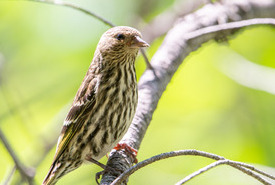
Pine siskin (Photo by Sean Feagan/NCC Staff)
Finches are adapted to foraging on seeds and, in some species, berries; none more obviously so than crossbills, with their bizarre, pincher-like bills that they use to pry open conifer cones. Because of their diet, finches can stick around over the winter, unlike insect-eating birds.
But that does not mean finches stay put. Instead, they form large flocks and search far and wide for reliable crops of their favourite foods. And because seed production by plants varies over time and space, each finch species shows up in fluctuating numbers across its range each year. So, for any given neck of the woods, a finch species might be abundant one year and scarce the next.
These patterns are predictable to some degree.
Much like the Farmer’s Almanac predicting whether each winter will be frigid, mild or somewhere in between, a group of researchers gives a “finch forecast” each year, outlining predicted trends in abundance and distribution for each species. The forecast is focused on eastern North America, so western birders like me must take a more wait-and-see approach.
This year’s forecast, released in December 2023, predicted that a poor cone crop in the boreal forest would result in large southward movements of crossbills and siskins, to name a few species. Can any eastern birders confirm?
Finch feeding frenzies
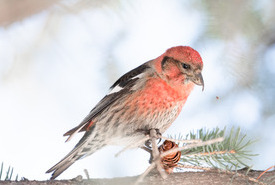
White-winged crossbill (Photo by Sean Feagan/NCC Staff)
It is amazing to watch a flock of hundreds of finches descend on an abundant food source and devour it in minutes before flying off.
Last year, my wife and I took a weekend getaway to western Alberta’s Bighorn country, where we encountered huge flocks of pine siskins, white-winged crossbills and red crossbills among the spruce and lodgepole pine forests there.
Their calls were nearly deafening as we watched tight flocks of these birds descend on a tree and feast for minutes, before flying to the next. My curiosity piqued, I wondered how they knew when it was time to move on?
Research suggests this question has been answered for white-winged crossbills. It appears that these birds stay relatively quiet when encountering plentiful food, but as they encounter less and less food while their flockmates chow down, they start calling more and more. As the calls of the flock reach a certain crescendo, they collectively decide it is time to take flight to move to the next tree or find a new foraging area altogether.
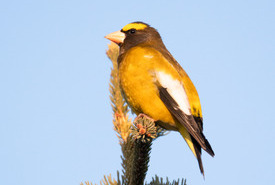
Evening grosbreak (Photo by Sean Feagan/NCC Staff)
Filling gaps in our knowledge of finches
When watching a flock of hundreds of finches, it could be easy to think their populations are limitless. However, there are troubling trends for some species.
In particular, evening grosbeaks have shown marked declines. According to data from the North American Breeding Bird Survey, evening grosbeak populations in Canda have declined by almost 88 per cent since 1970. Evening grosbeaks are listed as a species of special concern under Canada’s Species at Risk Act.
One of the ways we can help finches, including evening grosbeaks, is to collect data about their population through the intricate patterns of their abundance and distribution.
And there’s an exciting upcoming opportunity to do so — the Great Backyard Bird Count! Taking place this year over four days, from February 16 to 19, this event invites individuals to observe, count and celebrate birds.
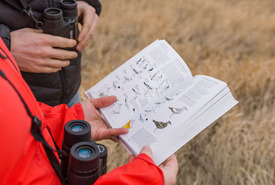
Birders with guide at Fairy Hill, SK (Photo by Carey Shaw)
It’s a great opportunity to get out into nature, which research shows benefits our physical and mental health.
By identifying, counting and submitting observations about birds, participants can help researchers map finch movements and identify key areas where more conservation efforts are needed.
So, why not go out and find some finches, for their sake and yours!
Learn more and sign up at the Great Backyard Bird Count.


